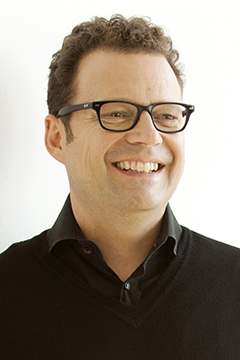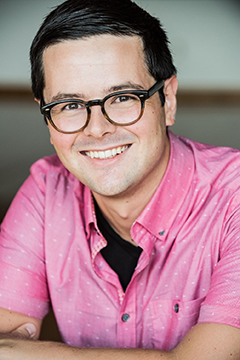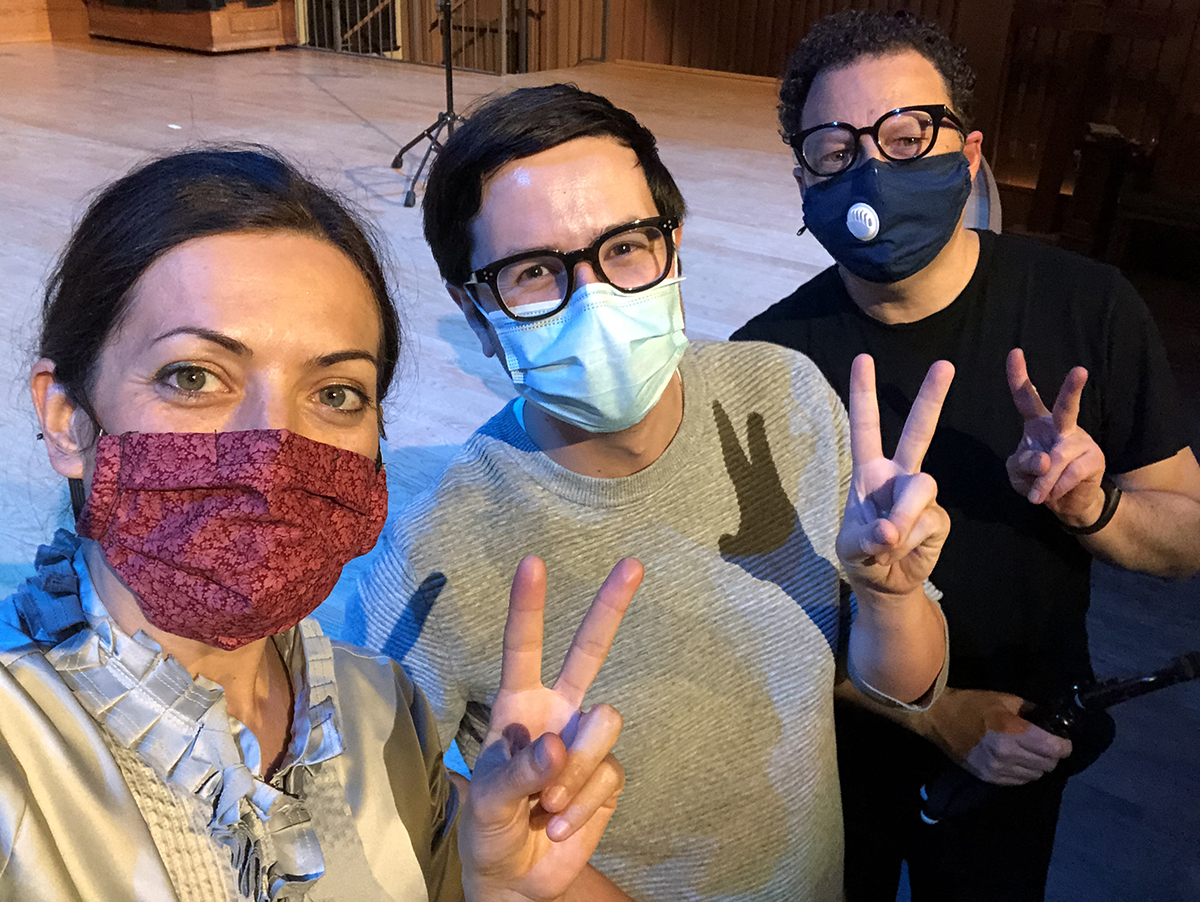Elisa Citterio, David Costello, and Marco Cera in Jeanne Lamon Hall
Tafelmusik's oboist Marco Cera and production manager David Costello talk about the process behind Tafelmusik’s latest video, Elisa's Midsummer Night's Dream, which conjures an imaginary return to the stage. Read our Q&A with them below, and then watch the video here.
Marco Cera, video director and oboe
Tafelmusik: In the opening scenes of the video we see Elisa Citterio riding her bike through the Annex, arriving to perform at TSP with her colleagues — something that would have been absolutely normal a few months ago, pre-pandemic. Where did the idea of framing this as Elisa's dream come from?

TM: How much collaboration was there between you and Elisa on the overall concept? To what extent did you direct her, or is she a natural in front of the camera?
MC: As soon as Tafelmusik asked me to produce this video, Elisa and I started exchanging initial ideas and thoughts. I illustrated my concept and she was pleased with it. We were totally on the same page from the beginning of the adventure. Elisa was also aware of my personal video projects, in which I’ve been cloning myself, creating a virtual “Marco band.” I explained that I was going to use the same technique for this Tafelmusik video, shooting the musicians individually and creating the illusion that they were performing together, and she was enthusiastic.
In terms of performing in front of the camera, Elisa is very natural, and many ideas developed in post-production by watching the expressions she used during the taping.
TM: The camera work is striking and invites a sense of exploration. What type of lens did you use, and how did you decide on camera movement and positioning?
MC: Elisa is not only a pro in front of the camera, but she also operated the camera (in this case, an iPhone).This was a very low-budget project where Elisa and I were juggling many tasks during the four nights of video shooting, including operating the cameras, which included a Canon 6D.
And if you want to know a secret, that bike riding scene at the beginning was filmed by me, holding the iPhone on the passenger side of my car while my wife was driving!
TM: The illusion that the musicians were performing in the same space at the same time was utterly convincing! The end caption explains that the full orchestra was brought together by “movie magic.” Are you willing to divulge another secret? Were the individual musicians’ audio tracks recorded separately?
MC: We filmed and recorded each musician separately and I completed the “puzzle” once I was at home, on my laptop, using a software program called Adobe Premiere Pro. There are no secrets, the technique is pretty simple, but you have to program everything in advance, mapping the floor of the stage, studying the music score, organizing movements and scene transitions beforehand. That is what Elisa and I had been planning for days before the actual filming.
On top of this careful planning, there is always a component of improvisation and spontaneity. In the opening seconds of the video when Elisa is riding her bike in the Annex, we hear a trumpet player practicing outside, which was completely coincidental and unplanned. It gave Elisa the opportunity to react and it worked beautifully.
TM: How were you able to coax such heartfelt performances from your fellow musicians under rather unnatural conditions?
MC: We Tafelmusik musicians are quite used to being in front of the camera for videos or photo shoots. Everyone was very engaged and eager to perform at Jeanne Lamon Hall for this project, even if under these strange conditions. After three months of practicing in our living rooms, let me tell you: the feeling of hearing your own sound reverberating in a beautiful resonant concert hall puts a smile on you face!
Sometimes I had to remind my colleagues about the final product and say something like “pretend that you are playing beside your viola colleague. Even if you don’t see him, look at him!” The result is incredible. It’s amazing how music and rhythm can synchronize the movements of the body.
TM: A project like this must have taken many, many hours of sound mixing and video editing. How familiar were you with those processes before embarking on this video?
MC: Let’s say that I never used the expression “I’m bored” during isolation. Not only many hours of audio and video editing, but hours of learning the different softwares. Video editing was totally unknown to me before the pandemic. I started digging in, as many musicians have had to do. I’ve been creating videos for Tafelmusik for #TafelmusikTogether campaign. This is an initiative by members of Tafelmusik orchestra, choir, and administrative team where we are finding creative ways to support each other and our patrons and audience with the comfort of music.
I also have been creating my personal video projects where I perform many different instruments, and were I try to unchain my creativity. They can be seen on my YouTube channel.
David Costello, Production Manager
Tafelmusik: The end credits indicate that physical distancing protocols were observed in the making of this video. What steps were involved to ensure the safety of musicians and crew during the production process?

TM: Making a video like this in the midst of a lockdown during a global pandemic is no easy feat. What was the biggest challenge from your perspective as production manager?
DC: Some of the greatest challenges working within the COVID reality is that a production manager has to remain flexible. Also the health and safety aspect of it and adapting to this new reality. Health and safety protocols are nothing new. My background in theatre trained me to take precautions around working at heights, working on top of a ladder or on an elevated scaffold or platform. This training is part of a long tradition, which we have internalized and it becomes almost automatic. However, with the coronavirus, there’s a whole other host of things that we now need to think about, and there isn’t that same level of training or experience, but it feels like the stakes are similar.
Many people have recovered from COVID-19 and are fine, but some don’t, so I feel like the stakes are high. You now need to be thinking about what people are touching and where things need to be placed. You create a plan, but you need to think on your feet, and it’s that thinking on your feet part that I would say is the challenge.
TM: Describe the level of emotion as each musician returned to the stage for the first time in almost three months.
DC: The question of emotion is interesting. A lot of musicians were happy to be back collaborating in person, and there was a lot of joy in hearing the instruments in the hall again, as opposed to simply in their bedrooms or living rooms or basements. But the threat of the virus was always hanging over everything we were doing. We weren’t allowed to get close, we had to wear masks, and you could never forget that we were in the middle of a pandemic. And I think that made people a little bit more closed off —not being able to hug someone after not seeing them for a couple of months. We had to be guarded with our physicality and in some ways, that made us guarded with our emotions. But I do think everyone was very excited to be there and to collaborate again, and it was great for Elisa to be able to see everyone before starting our summer break.
TM: How has the current pandemic reality affected the way you work?
DC: As a production manager, I’m always trying to say yes to things, to accommodate people’s requests and to advance the art or fundamentally just make people more comfortable. But there are certain realities about the pandemic that mean that you have to say no.
The virus requires a certain level of precaution that can feel almost silly at times, because fundamentally we’re not wired to gauge risk for something that you can’t even see or touch or feel. That’s difficult because the job is fundamentally about helping and enabling, and the virus changes the job in such a way that you have to scale that part back to keep everyone safe.
Something that’s really interesting is that in the before times, we had let ourselves become so specialized. Everybody had their job and their silo within the organization. But once the pandemic happened, we didn’t have the resources or the luxury of being able to stay within our little boxes. And so working on this project, we have Marco, our oboist, getting to use his talents in directing and editing video. Elisa, who is the artistic leader – you might even say she’s now free to get her hands dirty — she’s shooting video, she is setting up the space, she is doing everything and anything she can to move the process forward. It is communal and sort of equal, as we really come together to make what feels impossible happen. That’s really fun to see and it injects a great energy into the work.
The structures we create are efficient and precise, but there is something beautiful about the sort of chaotic, manic energy of losing all of those structures, so everybody has to do a little bit of everything. It’s nice to be reminded of that. When we go back to “normal”, can we bring that little bit of chaos back with us? I don’t know.
TM: Was additional lighting required, or did you use the in-house set up?
DC: We used the standard set-up in Jeanne Lamon Hall while we were there filming Elisa’s Dream. Working with Marco, I adjusted the overall levels and look and the lighting on stage, but another reality of the pandemic, funnily enough, is that we couldn’t bring people in to adjust the lights. We had to work with what was already there because we wanted to keep the group as small as possible. In fact, we weren’t even using the default Jeanne Lamon Hall set-up, because the lighting was still set up for The Indigo Project, which we did in late February. It’s the only program in the whole 2019/20 season where we radically altered the lighting set-up and it’s sort of funny that it’s the one that’s still there. We made it work, but it was definitely a surprise when I got there.
TM: You’ve worked extensively as a production manager in theatre and live music. How does the experience of working on this video compare with your past projects?
DC: I’ve worked in a lot of weird places under strange conditions, I’ll never forget working in an abandoned funeral home that had consistent heat issues. We were there in the month of December and it was a constant battle to get things working in that space. So the Elisa’s Dream video is not the strangest working situation.
What I come back to as I reflect on this video recording is that working in the arts, no matter what discipline, is an incredibly social and human experience. It’s something that attracts people who want to collaborate and work together. You can’t make music, you can’t make theatre, you can’t make dance without people, both on stage and behind the scenes. It’s incredibly labour intensive and there’s no way to mechanize that or get rid of the people. But COVID reduces that element in some ways. I think Elisa, Marco and I had a great sense of camaraderie as we as we worked through what we did. We were working under some pretty unique circumstances!
Surprisingly, the situation became normal very quickly during the shoot. We settled into the new routine and then things went back to focusing on how do we do the best work that we need to do. In some ways, the pandemic becomes another obstacle or another challenge to incorporate into the work that we do, in the same way that we incorporate other challenges and difficulties. You get very used to overcoming or incorporating obstacles into making art, because there’s never enough time, there’s never enough money, and there are never enough people to make things easy. So you spend your whole life overcoming obstacles being put in your way. It seems natural, then, that we would overcome, or work within, the restrictions that COVID imposes and thrive within them, because we’ve been doing that with all sorts of things before the pandemic, and will continue to do so afterwards.
Watch Elisa Midsummer Night's Dream here

